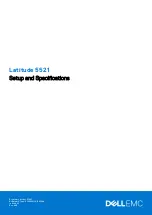
Installation and Configuration Manual
4. Configuring the Enhanced Media Gateway
SBA for Microsoft Lync
93
December 2010
Parameter
Description
Presentation
Determines whether Caller ID is permitted:
Not Configured = privacy is determined according to the Caller ID table.
Allowed = sends Caller ID information when a call is made using these
destination / source prefixes.
Restricted = restricts Caller ID information for these prefixes.
Notes:
Only applicable to Number Manipulation tables for source number
manipulation.
If 'Presentation' is set to 'Restricted' and 'Asserted Identity Mode' is set
to 'P-Asserted', the From header in the INVITE message includes the
following: From: 'anonymous' <sip: [email protected]>
and 'privacy: id' header.
4.10.2 Dialing Plan Notation
The dialing plan notation applies to the Number Manipulation tables, 'Tel to IP Routing' table and
'IP to Trunk Group Routing'. The dialing notation applies to digits entered for the destination and
source prefixes to represent multiple numbers.
Table
4-2: Dialing Plan Notations
Notation
Description
Example
[n-m]
Represents a range of
numbers.
Note:
Range of letters is not
supported.
[5551200-5551300]#:
represents all numbers from
5551200 to 5551300.
123[100-200]#:
represents all numbers from 123100
to 123200.
[n,m,...]
Represents multiple
numbers. Up to three digits
can be used to denote each
number.
[2,3,4,5,6]#:
represents a one-digit number that starts
with 2, 3, 4, 5, or 6.
[11,22,33]xxx#:
represents a five-digit number that
starts 11, 22, or 33.
[111,222]xxx#:
represents a six-digit number that
starts 111 or 222.
x
Represents any single digit.
54324:
represents any number that starts with 54324.
Pound sign
(#)
at the end of
a number
Represents the end of a
number.
54324xx#:
represents a 7-digit number that starts with
54324.
A single
asterisk (*)
Represents any number.
*:
represents any number (i.e., all numbers).
The device matches the rules starting at the top of the table (i.e., top rules take precedence over
lower rules). For this reason, enter more specific rules above more generic rules. For example, if
you enter 551 in entry 1 and 55 in entry 2, the device applies rule 1 to numbers that start with 551
and applies rule 2 to numbers that start with 550, 552, 553, 554, 555, 556, 557, 558 and 559.
However, if you enter 55 in entry 1 and 551 in entry 2, the device applies rule 1 to all numbers
that start with 55 including numbers that start with 551.
















































